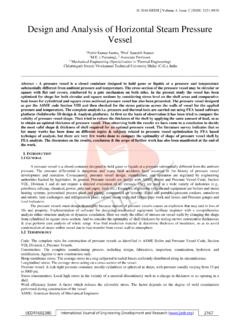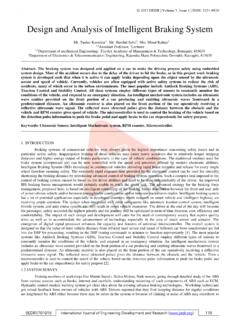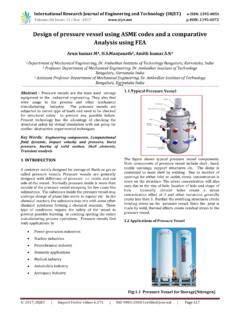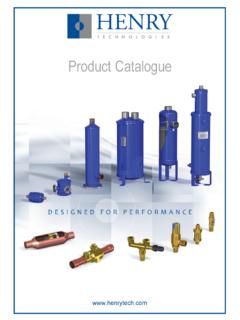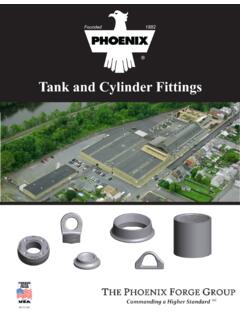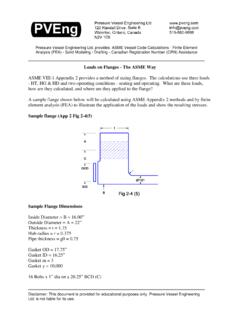Transcription of Design and Study of Floating Roofs for Oil Storage Tanks
1 2016 IJEDR | Volume 4, Issue 4 | ISSN: 2321-9939 IJEDR1604001 International Journal of Engineering Development and Research ( ) 1 Design and Study of Floating Roofs for Oil Storage Tanks Authors: Prof. Dr. Mohamed El-Samanody *, Dr. Ashraf Ghorab*, Ahmed Saad Noaman** *Department of Mechanical Power Engineering Ain Shams University **Senior Mechanical Engineer - Petrojet _____ Abstract - Floating Roofs are widely used to store petroleum products with high volatility. This is to prevent the product loss and to ensure safe environment around the Storage Tanks . However, small number of researches were accomplished. These researches aim at Study the Design of the Floating roof and the associated risks that it faces during operation.
2 In an effort to compensate the lack of knowledge for this issue and to investigate the behavior of the Floating roof during operation, this paper studies the Design of deck plate and roof pontoons of the Floating roof with especial features. In this research and in order to Study deck plate Design , a comparative work was performed of the stress and deflection analyses of deck plate for the Floating Roofs under the load of accumulated rainfall. Five different loads were applied on the deck plate by using three different analysis methods to Study the deflection and stresses. The results show that the nonlinear finite element analysis is the most accurate and applicable one to be used in the Design of the Floating roof deck, since it simulates the exact loading cases that happen in reality.
3 However, using Roark's Formulas gives higher results but it can be used as a reliable and fast method in the analysis of the deck plate. To Study roof pontoons Design , a buoyancy analysis of the Floating roof was established with punctured pontoons. In this Study , three cases were applied to analyze the buoyancy of the Floating roof in each case. The obeyed methodology of this Study is by calculating the center of gravity and moment of inertia of the Floating roof in each case. Then, to determine the submergence height due to weight and tilt and ensure that the Floating roof will keep Floating under each case.
4 The results show that the Floating roof will remain Floating after the puncture of two adjacent pontoons and deck plate according to the Design of the physical model; but it will sink if the number of punctured pontoons is increased to three. Keywords - Tanks , Floating Roof, Plate Deflection, Large Displacement, finite Element analysis , Nonlinear analysis , Pontoon. _____ I. INTRODUCTION Storage Tanks are essential part in industry in oil & gas fields. They are mainly used to store different fluid products such as water, oil and gas. To transport fluids from places of production to end users, we need Storage Tanks to store the products.
5 Storage Tanks were a key factor of the development of dozens of industries. Petrochemicals industry is a good example for the importance of Storage Tanks as it couldn t be developed without the ability to store huge amount of crude and refined oils products in a safe and economic storages. Another example of the usages of storages Tanks are the processing plants such as chemicals factory and food processing factories; since production pauses are always occur to allow reactions at different stages. Also, after ending the production process, we need safe and huge storages as the products cannot transport immediate to the customers and end users.
6 The majority of the Storage Tanks are working under atmospheric pressure. According to API 620 [1] the maximum allowable pressure for Storage Tanks is 15 psi and if the pressure is larger than this value, it is considered as a pressure vessel. [2] Floating roof tank; as its name; implies the roof to float on liquid surface in the tank. As the liquid level changes due to filling, emptying, contraction and expansion, the roof is designed to move with the liquid. This type of Tanks used for 2 main reasons; 1. Minimize the loss of the stored liquid product inside the tank due to evaporation by eliminate the free space above the stored liquid.
7 2. Minimize the fire hazard by decreasing the volatile gases inside the tank. Main two Types of Floating Roof Tanks - Single deck Floating roof In single deck roof, which is also called pontoon roof, the buoyancy is derived by the pontoons, according to API 650 [3]. The deck of single deck Floating Roofs shall be designed to be in contact with the Storage liquid during normal operation, regardless of the service. 2016 IJEDR | Volume 4, Issue 4 | ISSN: 2321-9939 IJEDR1604001 International Journal of Engineering Development and Research ( ) 2 Figure (1) Single deck roof. - Double deck roof It consists of upper and lower steel membranes separated by series of bulkheads, which are subdivided by radial bulkhead.
8 Double deck roof is more rigid than the single deck and the air gap, between the upper deck and bottom deck plates, works as an insulation which reduces the solar heat reaching the product during the hot weather. Figure (2) Double deck Floating roof. Different researches have been developed to Study the Design of the Floating roof and predict its mechanical behavior of the different parts and analyze its failure mechanism under different loads. First, the Study of stress and deflection analyses of Floating Roofs under rainfall loads [4]. This paper proposes a load modifying method for the stress and deflection analyses of Floating Roofs .
9 The formulations of deformations and loads are developed according to the equilibrium analysis of the Floating roof. According to these formulations, the load modifying method is generated to conduct a nonlinear analysis of Floating Roofs with the finite element simulation. The analysis is developed through a series of iterations until a solution is achieved within the error tolerance. Also, there is a Study of damages of a Floating roof-type oil Storage tank due to thermal stresses [5]. This paper studied whether the thermal stress on the Floating roof could cause damage, strain and temperature measured on the actual tank s Floating roof by using optical fiber gauges.
10 Thermal stress analysis and fracture estimation were also carried out as additional analysis . As a result, thermal stress on the Floating roof turned to be relatively small and could not cause the initial crack. However, the temperature variation in a day could affect the crack propagation. Another Study was for the importance of the flexural and membrane stiffness in large deflection analysis of Floating Roofs [6]. Applying integrated variational principles on fluid and deck plate to the large deflection analysis of Floating Roofs , this paper studied the significance of the flexural and membrane components in the formulations of the deck plate.

